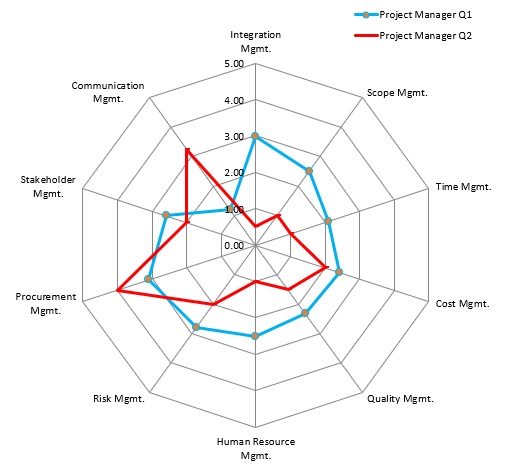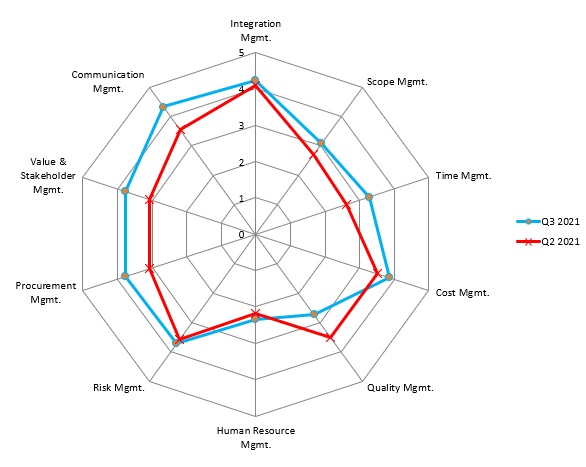Have you ever been told to improve but weren’t sure what to work on? Have you asked your team to do better and improve their performance—and then, a week later, the group wants to have a discussion about precisely what that means?
Hi, I’m Peter Nichol, Data Science CIO.
What is Team Point?
Today, we’re going to talk about a concept I created called Team Point. Team Point is an approach for providing individuals and teams with a quantifiable baseline for performance.
If you’re a team leader and are charged with improving that team, this approach is enormously powerful. The beauty of Team Point is that it offers a method to measure the team’s progress toward a quantifiable objective. No longer will you be introducing techniques and not be able to link them to performance. From now on, every best practice you implement can be measured and quantified to determine your team’s positive (or negative) effect.
What problem are we solving?
Have you ever taken ownership of a new team or joined a new organization? Initially, the role sounded straightforward. Then, you heard rumors of the team not delivering. Stakeholders were getting increasingly frustrated because quality varied from product to product and manager to manager. You’ve started to get more requests for named individuals, resulting in some staff being overallocated and others being under-allocated.
When everything is on fire, where do you start? These fires pop up almost everywhere:
- Deliverables are being missed.
- Issues aren’t communicated.
- Risks aren’t escalated in a timely fashion.
- Critical milestones are delayed, resulting in additional escalations.
- Project meetings have conflicting agendas.
- Stakeholders want team members removed.
When everything is on fire, one thing is for sure—you can’t be running from hot spot to hot spot. That doesn’t work. Here’s what does work.
Choose a framework for evaluation
This hot environment requires an organized and systematic approach. Team Point works by applying an evaluation method of, “show me, don’t tell me.”
It’s essential to choose a framework and identify categories that accurately represent the areas of competency that you’re interested in evaluating. This will vary depending on the role, industry, and domain. I’ll share what I use for project and program management areas to demonstrate competency. I’ve found that these categories—originated from a previous PMI PMBOK version—work exceptionally well to capture the significant elements of project management competence.
Project Management
- Integration management
- Scope management
- Time management
- Cost management
- Quality management
- Human Resource management
- Risk management
- Procurement management
- Stakeholder management
- Communication management
I’ve adjusted some of the competence areas for program managers to make them more strategic and outcome-focused in nature.
Program Management
- Program portfolio management
- Strategy and investment funding
- Program governance
- Program management financial performance
- Portfolio metrics and quality management
- Program human capital management
- Program value and risk management
- Program contract management
- Program stakeholder engagement
- Communication management
The PMI PMBOK 7th edition was released on August 1, 2021. There are valuable pieces that leaders may want to pull from this text. I’ve referenced the eight most functional performance domains:
Performance Domains (PMBOK 7th edition)
- Stakeholders: interactions and relationships
- Team: high performance
- Development approach and lifecycle: appropriate development approach, planning, organizing, elaborating, and coordinated work
- Project work: enabling the team to deliver
- Delivery: strategy execution, advancing business objectives, delivery of intended outcomes
- Uncertainty: activities and functions associated with risks and uncertainty
- Measurement: acceptable performance
It’s critical to select areas of competency that resonate with your executive leadership. Don’t feel you have to use conventional categories. Much of the value of this framework comes from experienced leaders tailoring the areas of competency to their business purpose and desired outcomes.
Identify questions to demonstrate competency
The majority of questions I receive about Team Point is how to administer the approach in a real setting. So, I’ll share a specific example of how this works and why the system is uniquely impactful.
No one wants to be told how to think. The close follow-up to this is, managers always have unique or creative ways of operating that they’ve matured over the years. Some of these techniques are unusual but effective, while others have deteriorated over time. Here are a few examples in practice.
Contact Lists
First—in this case—I sit down with the project manager and ask about how they manage the contacts for the project. The trick is, there’s no “right” answer here, but there are wrong answers. The tool they use to track contacts doesn’t matter. I’m also not checking for the frequency of how often that list is updated. The project manager will either produce a contact list or say why it matters that I know who to contact.
In this case, I’ll pose a question: “You’re on PTO (paid time off), and the business analyst on your project wants to contact the tech lead. Where do they go to find that information?” It’s clear how inefficient communication will be if those business analysts have nothing to reference.
If the project manager is organized, they might have a contact list documented in Confluence. The project manager could have a project list included in a project charter. There may be a SharePoint library with contacts listed. Each of these is a reasonable solution. The goal is to create a reasonable approach for the business analyst to get to that information. Often, I’ll hear something like, “Well, everyone knows how to find that contact information, even if it’s not documented.” I’ll usually reply with, “If we text, Michelle, your business analyst, now, she’ll know how to find the database lead’s cell phone number, right?”
The value here is asking the project manager to show me—not tell me—where the information is located. I’ll have the project manager do a screen share and navigate where the business analyst would find relevant contact information.
If the project manager can’t find the information in five to 10 seconds, it’s a pretty good bet the business analyst would have no idea where to find that contact information.
How does Team Point change behavior?
As leaders gather more experience, they can articulate situations more clearly—even when they aren’t all that clear. A good example is our contact list question. It’s easy to explain how the information would be shared among team members. However, it’s much harder to demonstrate how to set up and execute that process to achieve the desired outcome effectively.
So, how does Team Point change behavior? It measures what matters.
We’re defining the standard upon which each individual and every team member will be measured. Most teams have goals, but ask for clarification of the goal there is no supporting detail. It’s simply a vast wasteland of assumptions.
This is where we add clarity—because being measured against a standard that isn’t defined sucks. It’s also not fair to your team. The standard for good performance should be visible and transparent to everyone on the team. There’s no grey performance in this model. You’re either above the line or below the line.
Using gamification to drive desired outcomes
If there’s not a clear standard for good performance, the team operates in this fuzzy state. They make some effort but never exert all their energy because the objective isn’t clear.
Do you need a contact list? Do you need an architecture plan? Do you need to schedule weekly meetings? The project manager can guess but doesn’t know for sure. Maybe they should know, but perhaps they shouldn’t.
This model defines behavior that’s expected 100% of the time. There is no longer any question about what’s expected. Of course, based on the size of projects, some models require more artifacts or less, but what’s relevant here is, even then, what’s expected is clear. There’s no grey.
Every team member knows their unique score based on their demonstrated competency, and they also know how they’d rate the entire team. This creates healthy competition among team members without adding undo team friction.
How to implement Team Point
Our goal is to provide individuals and teams with a quantifiable baseline for performance. To administer the evaluation, the same questions need to be asked of each individual in a similar role. For example, all project managers should have the same (or a very similar) set of questions. The same logic applies to program managers. Therefore, all program managers should receive the same questions. This ensures that results can be aggregated and rolled up smoothly.
Here’s how you start to roll out Team Point for your group:
- Choose categories for evaluation
- Identify your questions related to each category
- Determine acceptable answers
- Conduct the Team Point assessment
- Report individual and team results
You want managers to think, so, explain what you’re looking for, not how to produce those results. For almost every question, there are multiple approaches to the answer that are acceptable.
How to measure and report results
There are two levels of reporting results: individual and team.
The individual results are specific to that resource and address their areas of strength and weakness. The team results show rolled-up performance and represent the directional performance of the team.
Illustration 1.0 Individual Performance

Individual performance is always accompanied by detailed explanations of how the individual performed compared to the team, on average. This helps an individual understand precisely how they’re performing in relation to their peers. While the below percentages in the below example don’t represent the graphic above, when distributing individual results, the graph and the percentages would match.
- Integration management: 33% vs. 55%
- Scope management: 78% vs. 45%
- Time management: 78% vs. 32%
- Cost management: 78% vs. 76%
- Quality management:. 43% vs. 11%
- Human Resource management: 44% vs. 33%
- Risk management: 87% vs. 51%
- Procurement management: 51% vs. 42%
- Stakeholder management: 86% vs. 67%
- Communication management: 13% vs. 23%
Team Point is powerful in that you’re able to show individual performance charted over team performance. So, for example, you’d compare Q1 versus Q2 performance of a particular project manager.
Illustration 2.0 Team Performance

You’d also report team performance quarter over quarter. This helps to illustrate directional progress and precisely measures any best practices or elements you, as a leader, introduced that might improve team results.
This gives resources a view of where they are individually, how they rank against the team as a percentage of effectiveness, and where they are compared to the previous quarter.
Why it’s so powerful
This model translates soft activities into complex outcomes. For example, let’s assume that, over the quarter, you made some adjustments to the team:
- The lifecycle steps were reduced.
- The team was retrained on financial management.
- Maintenance of artifact documentation was transitioned to a project coordinator.
- An intern model was introduced, and two new interns are assisting senior-level project managers.
- The project management meeting structure was optimized.
How do you measure any of these benefits? It’s possible, of course, but it’s extremely challenging. Using Team Point, you can link the best practices you implemented to a demonstrated competency model that can be quantified.
Hopefully, these insights offer a new perspective on using Team Point to precisely pinpoint where your team needs to improve and, similarly, where they’re performing strongly.
If you don’t subscribe to my newsletter, please do so at newsletter dot data science CIO dot com. I share insights every week to a select group of individuals on new concepts in innovation and digital transformation that I’ve been made aware of and love to share.
If you found this article helpful, that’s great! Also, check out my books, Think Lead Disrupt and Leading with Value. They were published in early 2021 and are available on Amazon and at http://www.datsciencecio.com/shop for author-signed copies!
Hi, I’m Peter Nichol, Data Science CIO. Have a great day!
